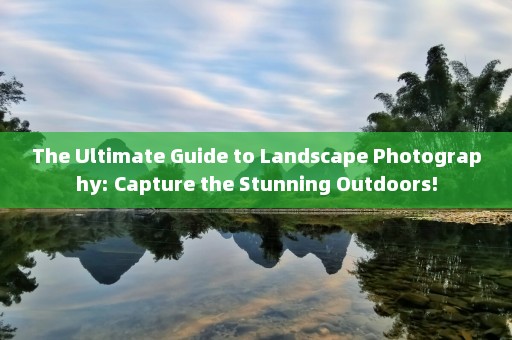Have you ever stumbled upon a breathtaking landscape that left you in awe, only to find that your camera fails to capture its true beauty? I was in that exact situation a few years back, standing on the edge of the Grand Canyon, trying to encapsulate its grandeur. Little did I know then that landscape photography is an art that requires more than just a pricey camera. Today, I'm going to share with you my journey and the ultimate guide to landscape photography that will help you capture the stunning outdoors!

Understanding the Basics
Before we dive into the technicalities, let's establish the foundation of landscape photography. It's all about capturing the vastness of nature, the play of light and shadows, and the unique elements that make a location special. Here are some key aspects to consider:
1. Composition
Composition is the key to a captivating landscape photo. The rule of thirds is a great starting point, where you divide the frame into thirds both horizontally and vertically. Place important elements of the scene, like the horizon or a tree, along these lines or at the intersections for a balanced composition.
2. Light
Lighting is everything in photography. The golden hour, which occurs shortly after sunrise and before sunset, provides warm, soft light that can add a magical touch to your landscape shots. Similarly, blue hour photography, taken during twilight, can create a serene atmosphere. Avoid shooting in harsh midday sunlight, as it can wash out colors and create unwanted shadows.
Equipment and Settings
Now that we have the basics covered, let's talk about the tools of the trade. The right equipment and settings can make a world of difference in landscape photography.
1. Camera
A DSLR or mirrorless camera with manual settings will give you the most control over your shots. Invest in a good quality wide-angle lens to capture the vastness of the landscape.
2. Tripod
A sturdy tripod is essential for landscape photography, especially in low-light conditions or when you need to capture long exposures. It ensures sharp images and allows you to experiment with different compositions.
3. Settings
Shoot in RAW format to retain maximum image quality and have more flexibility during post-processing. Use aperture priority mode (AV or A) and set your aperture between f/8 and f/16 to achieve a deep depth of field, ensuring both the foreground and background are in focus. Set your camera to manual focus and use live view to ensure critical focus.
Practical Tips and Precautions
Now that you have the basics and equipment sorted, let's dive into some practical tips and precautions to enhance your landscape photography skills.
1. Scout the Location
Arriving early at your chosen location allows you to scout for the best spots and compose your shots. Research the area beforehand to find unique perspectives and consider using apps like TPE (The Photographer's Ephemeris) to plan your shoot according to the position of the sun and moon.
2. Use a Polarizing Filter
A polarizing filter can reduce glare and reflections, enhancing the saturation of colors and improving the overall clarity of your landscape photos. It's particularly useful for shooting water and skies.
3. Experiment with Different Perspectives
Don't be afraid to get creative with your compositions. Shoot from different angles, lie on the ground, or climb to a higher vantage point. These unique perspectives can add a fresh twist to your landscape photos.
4. Be Patient and Observant
Nature is unpredictable, and sometimes you might have to wait for the perfect moment. Be patient and observe the changing light and weather conditions. Some of the most stunning landscape photos are captured during unexpected moments.
Enhancing Persuasiveness with Data and Examples
To further emphasize the importance of these techniques, let's look at some data and examples that support the key points mentioned earlier.
1. The Power of Light
According to a study by the Journal of Vision, the human eye is most sensitive to green and red colors during the golden hour, which explains why landscape photos taken during this time have a warm, inviting feel. Compare these two images: one taken during midday and the other during the golden hour. Notice the difference in color temperature and overall atmosphere?
2. The Impact of Composition
A well-composed landscape photo can evoke emotions and tell a story. The rule of thirds, leading lines, and other composition techniques can significantly enhance the visual appeal of your images. Look at this example: the composition guides the viewer's eye through the frame, creating a sense of depth and wonder.
Conclusion
landscape photography is an art that requires practice, patience, and a deep understanding of the environment. By following these guidelines and embracing your creativity, you'll be well on your way to capturing stunning outdoor landscapes that leave a lasting impression. So, grab your camera, head outdoors, and start clicking!
Remember, the key to landscape photography is not just about having the latest gear, but also about understanding the basics, being patient, and having a passion for the outdoors. Happy shooting!
Post a comment

Comment List